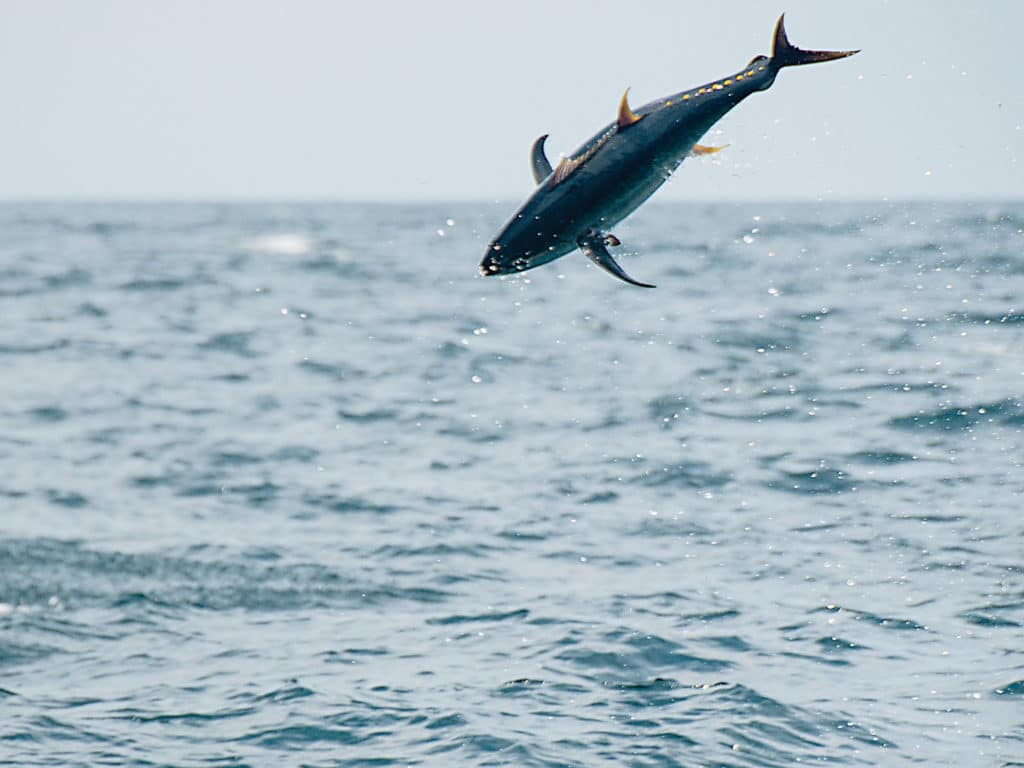
AIR TIME
Like a ballroom dancer, Fred Vial maneuvered his 36-foot catamaran behind the slow-moving trawler until the bow nearly touched the taut cable running off the extended boom. Once in position, Chris Benson, Vial’s nephew, reached into a plastic bushel basket and tossed handfuls of chum overboard, beneath the creaking boom.
The dead croakers, spot, ribbonfish, squid and other detritus drifted in the wake before sinking into the blue-green depths. Suddenly, dark shapes appeared, darting back and forth as the bait disappeared.
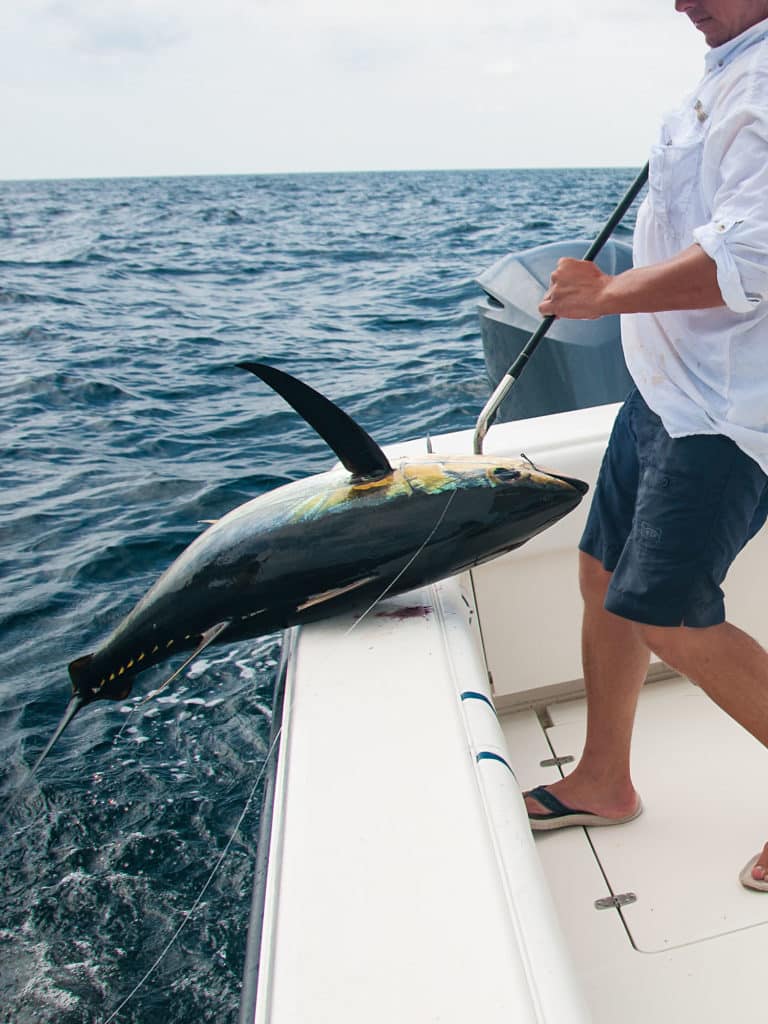
HEFTY REWARD
“We’ve got visitors,” I shouted as the other crew members readied fresh chunks of bonito in the cockpit. I heard the audible clicks of reels as the line was pulled off by hand. Less than a minute later, a welcome cry came: “Fish on. It’s a fat blackfin!”
We were about 30 miles southeast of Louisiana’s Grand Isle when that scene played out last fall. I first met this extended family crew while testing Vial’s Calcutta 390 a couple of years prior. That’s when they offered me a return invitation to witness this developing shrimp-boat fishery, and I gladly accepted.
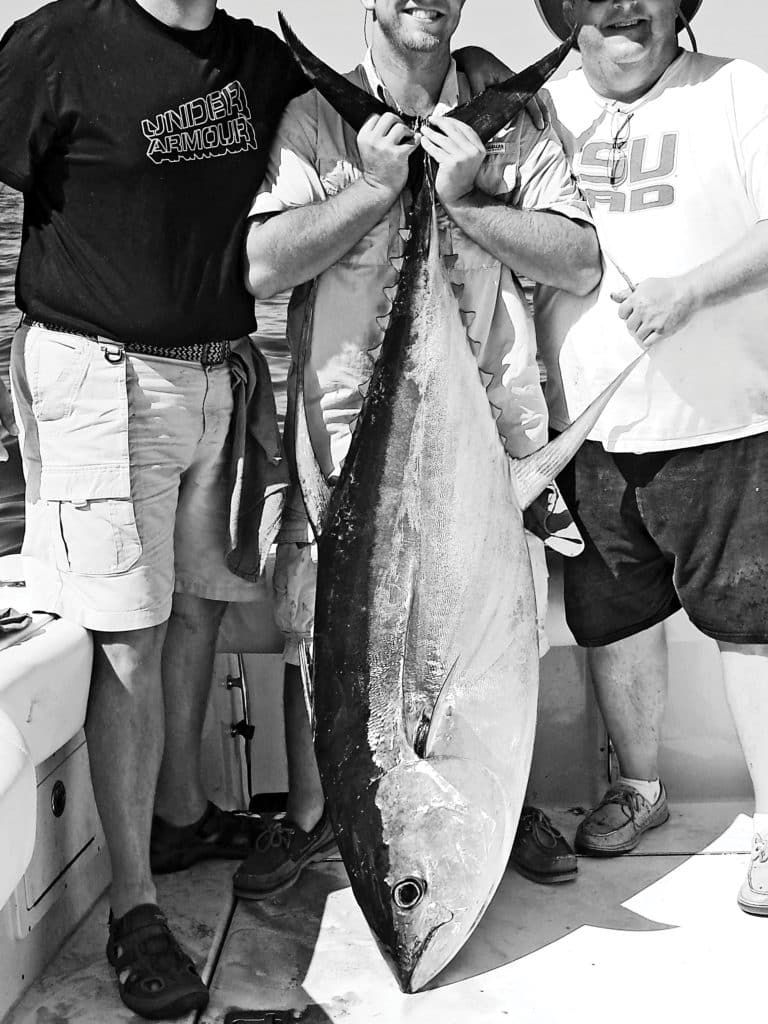
CHUM IS KEY
GAME ORIGIN
“This all originates with Key West,” Vial explains. The radiologist and avid angler survived medical school studies by reading Salt Water Sportsman cover to cover and dreaming about owning an offshore boat. After learning about the shrimp-boat action near the Dry Tortugas in the magazine, he started researching similar possibilities off his native Louisiana coast. But it was Benson — while in the family bay boat, no less — who confirmed that large tuna did indeed collect behind the local shrimping fleet.
“We probably shouldn’t have been that far out,” he admits, “but it was slick calm, and we were so stoked to find yellowfins behind the shrimpers that we really didn’t care. Oh, and by the way, the fish we found were huge yellowfins, all over 100 pounds.” Benson relayed his findings to Uncle Fred, and the team spent the last few seasons perfecting its tactics.
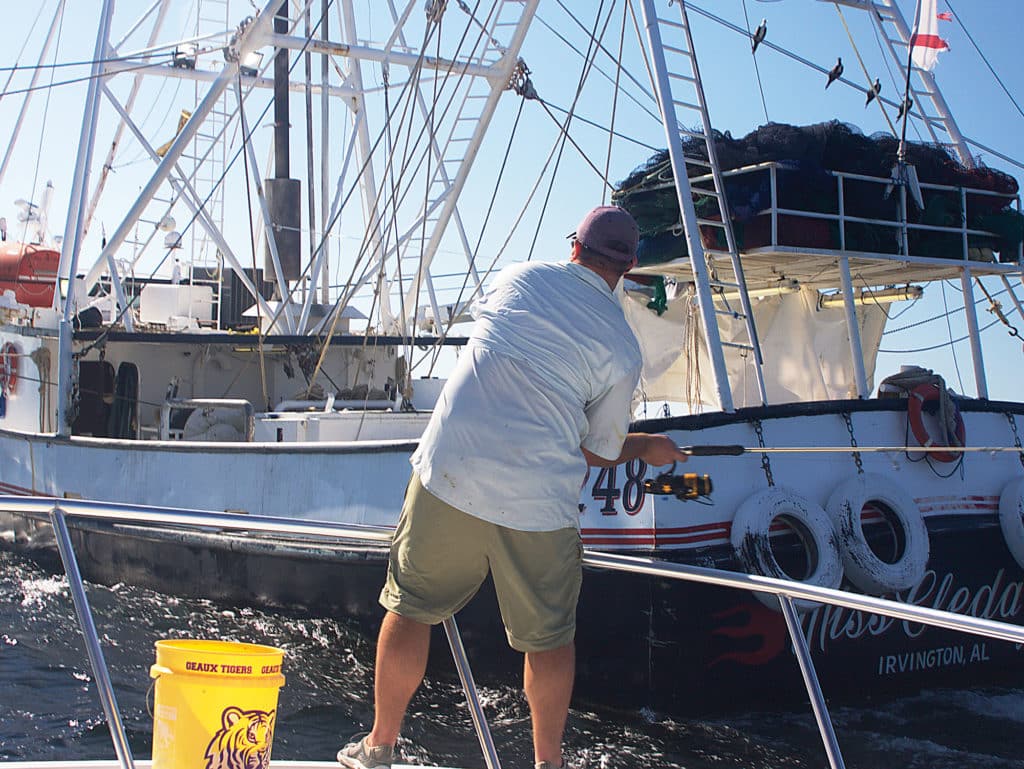
CLOSE QUARTERS
LOCATING SHRIMPERS
The shrimp boats trawl in depths of 250 feet or less and typically dump their nets first thing in the morning after dragging all night. The nets are emptied on the deck of the boat, and the commercial fishermen pick the shrimp out by hand. The bycatch is then shoveled overboard, and the dead baitfish, crabs, eels and other marine life form an oily buffet in the water that quickly attracts predators, including trophy-size yellowfins, blackfins, bonito and sharks. Vial and company also recall catching a marlin scrounging through the mix once.
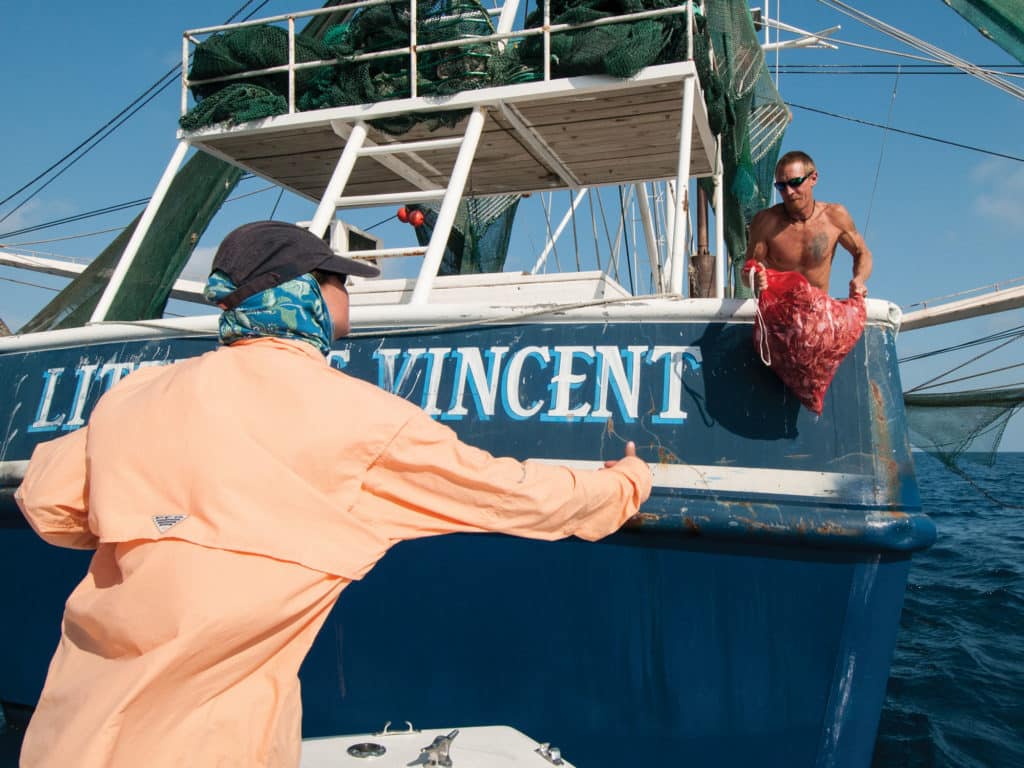
MORNING TRADE
“Finding the shrimpers in blue water is always the best,” Vial says. “But we’ve also caught tuna in pretty green water. Ideally, you find a boat that’s been out there for a few days to set up a pattern, but sometimes we’ll run to nearly every boat to get chum if nothing else. You go through a lot of it. We’ll trade for the bycatch to establish a rapport with the shrimpers and then start chumming. If I spot marks on the sonar and we see bonito and blackfins, we’ll stick around. If the yellowfins are there, you know it immediately.”
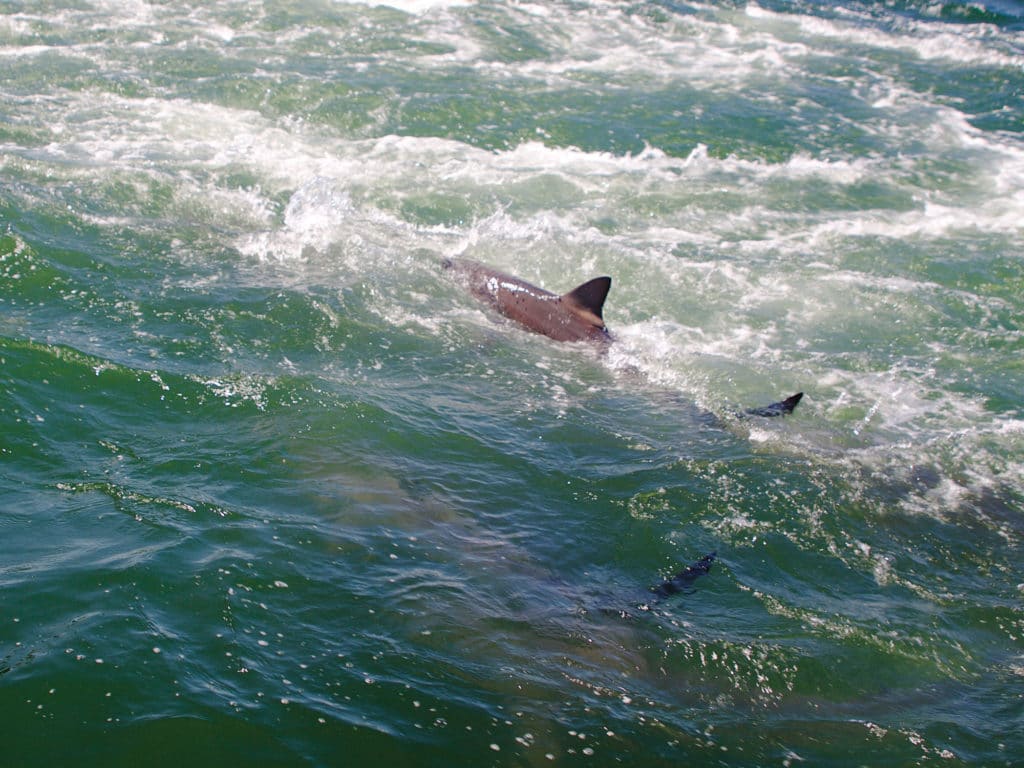
SHARK INFESTED
COLLECTIVE EFFORT
This fishing is definitely a team effort. Someone has to be at the helm at all times. One or two designated chummers toss a constant flow of bait while others keep up with the resulting mess. The anglers steadily pay out line, keeping pace with the drifting chum. Once a triple-digit yellowfin inhales a hooked bait, it’s game on, and Benson says they often pull a school of tuna away from the shrimp boat by slowly drifting while keeping the chum flow going.
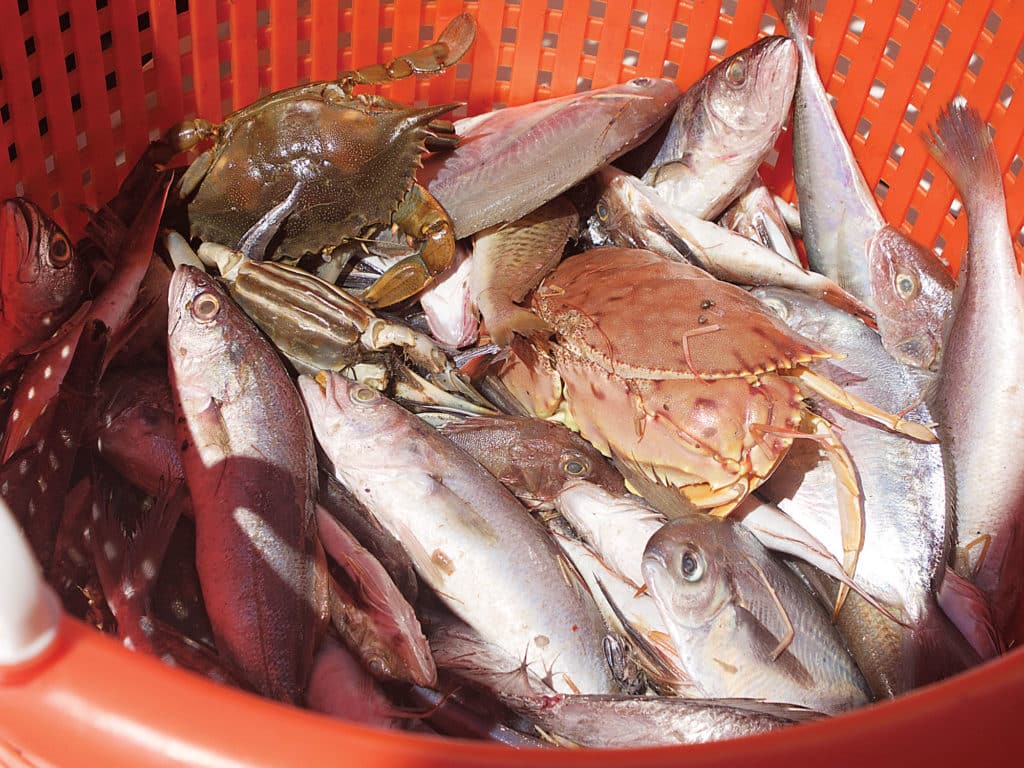
VARIETAL MENU
PATIENCE PAYS
“It can be an absolute aquarium out there,” Benson says. “Sometimes you find nothing but bonito behind one boat, and the next will be nothing but sharks. If the sharks show up, move on to another shrimper. But if you see blackfins, you’ve got to be patient and work it, ’cause the yellowfins could be right behind. It’s a little bit like the lottery. You have to get lucky, but when you finally find tuna, it’s nonstop action.” Benson says on their best day they found yellowfins at 7 a.m. and stayed with them, continually pulling in fish until 4 o’clock that afternoon. When they left, the tuna were still biting. The largest topped 200 pounds.
“We were completely exhausted like gladiators at the Coliseum,” he says with a laugh. “Most of the yellowfins we’re finding behind the shrimpers are big fish. You just don’t see many 60- and 80-pounders.”
BEEFY TACKLE
Although they’ll use heavy spinning gear to catch bonito for bait, Vial and Benson stick with beefy conventional outfits for the main event. “We fish heavy tackle because we’re meat eaters,” Vial says. “We don’t like broken lines, we want fish in the boat.” According to Vial, water temperatures are not really a factor during the fall shrimp migration. September and October are prime, although the shrimping season may extend into early November with mild weather. The targeted depths lie about an hour’s run from their camp on Grand Isle. The typical routine entails leaving the dock before dawn to intercept the shrimp fleet, load up on chum, and be in position as soon as possible after first light when the bycatch usually goes overboard.
“It really is a fun fishery,” Vial adds. “It’s truly run-and-gun fishing, hopping from boat to boat. We get a lot of action catching bonito and chumming. And with a little bit of luck, the yellowfins are there, and we stay with ’em for a long time.”
It takes two skilled partners to really dance the tuna tango. Off the Louisiana coast every fall, the partners are shrimp boats and those anglers willing to get close enough to embrace the rhythm, step for step. The rewards are certainly worth the extra effort, both on the dance floor and again at the dinner table.
FAST FACTS FOR SUCCESS
1. BARTER BOOTY: Shrimpers gladly accept beer, soft drinks or ice cream for the bycatch anglers use to chum.
2. SHARK WARNING: There’s no shortage of shrimp boats off Louisiana’s coast, so if sharks are thick behind one, just move on to another.
3. ADVANCE NOTICE: Bonito and blackfin tuna are good harbingers for yellowfins. Be patient and continue chumming.
SWS PLANNER
Gulf of Mexico yellowfin and blackfin tuna
What: Yellowfin and blackfin tuna
Where: Gulf waters 25 to 35 miles off the southern Louisiana coast
When: September and October
Who: Anglers on midsize to large center consoles and walkarounds can take advantage of the shrimp-boat tuna fishery, departing from any of several public ramps and private, full-service marinas, including Bridge Side and Sand Dollar marinas on Grand Isle, nearby Port Fourchon Marina, or Venice and Cypress Cove marinas in Venice. Many offer lodging, restaurants and supermarkets, aside from fuel, dockage and trailer storage. The following captains can also get you hooked up:
Capt. Chris Moran Ph: 985-396-2727 moransmarina.com
Capt. Lance Walker Ph: 225-445-1005 fishcommander.com
SWS TACKLE BOX
Gulf of Mexico yellowfin and blackfin tuna
Rods: 5- to 6-foot stand-up
Reels: 30- and 50-pound conventional, such as the Shimano Tiagra
Lines: 130-pound braid backing connected with double uni knots to 100 yards of 80-pound monofilament top shot
Leaders: 20-foot wind-on leaders of 130-pound fluorocarbon
Baits: Chunks of freshly caught bonito or culled baitfish from the shrimp bycatch; 7/0 to 10/0 circle hooks hidden inside the chunks of baitfish
TACKLE TIP
Tie the circle hook directly to the leader and never loop the hook through the rod-guide frames or the reel seat when moving from one shrimp boat to another. Instead, reel in the leader all the way until the hook stops at the rod tip. This prevents the leader from kinking so the bait chunks look as natural as possible when drifting back in the chum slick.









